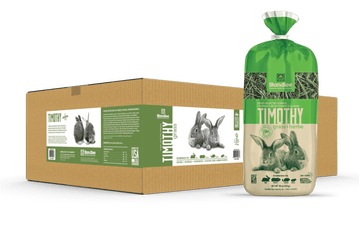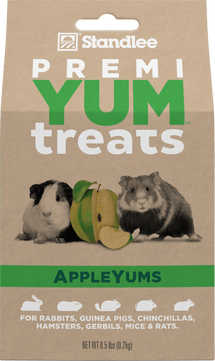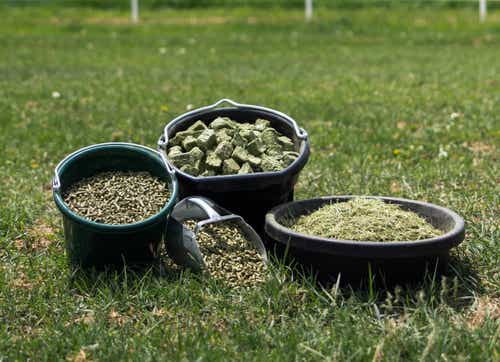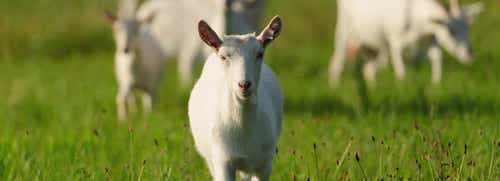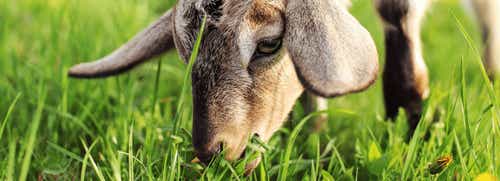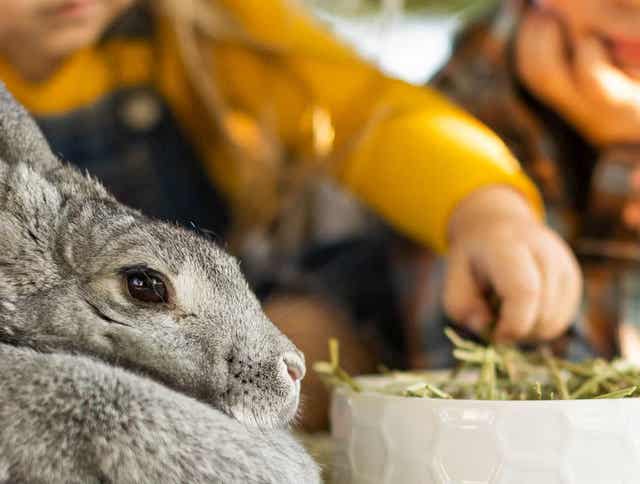
Digestive Health in Rabbits
Having a rabbit as a small companion animal is very popular. As a companion animal, the rabbit relies on its caregiver to provide a proper diet that will maintain both digestive and overall health. A diet not properly suited for a rabbit will cause major digestive issues that can lead to the death of the rabbit. The first step to ensuring your rabbit maintains digestive health is to understand the rabbit’s unique digestive system.
The Digestive System
In the wild, rabbits spend their time nibbling tender plant material. Rabbits are classified as herbivores, meaning they eat and extract nutrients from plants. Their digestive system is uniquely designed to digest plant material, that we humans have no hope of digesting. Rabbits themselves do not have a rare “super-power” ability to digest fiber from plants. Instead, rabbits rely on hindgut bacterial fermentation of plant material to break it down and extract nutrition. Rabbits also rely on some unique nutrient recycling and sorting techniques to enhance digestive efficiency. See the figure below to see this process visually.
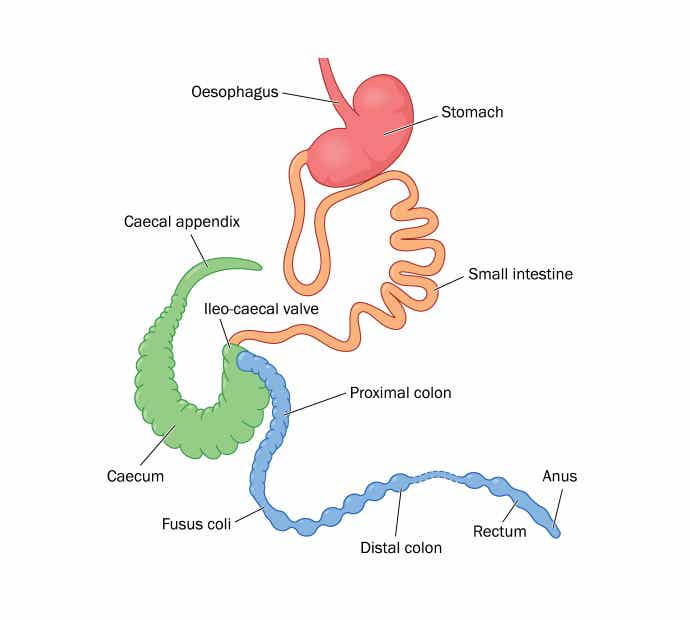
- Like all animals, the digestive process begins in the mouth. Rabbits bite and chew plant material, adding saliva and digestive enzymes. The plant material is chewed to a particle size that is small enough so they can swallow.
- The chewed food travels down the esophagus to the stomach. The rabbit stomach is very acidic, and this acid further breaks down food material. The rabbit stomach is different from the human stomach in that it contains a tight seal where the esophagus empties into the stomach. This tight seal prevents rabbits from being able to vomit.
- The small intestine is the next digestive structure. The rabbit small intestine is not very long, only making up about 12% of the digestive capacity, compared to that of a horse which makes up approximately 25% of the digestive capacity. In the small intestine, digestive enzymes digest protein, fat, simple carbohydrates, along with most vitamins and minerals.
- Undigested plant material then travels to the hindgut which consists of the cecum and colon. This is the area of the digestive system where rabbits are unique. When food material leaves the small intestine and enters the hindgut, the fibrous material is separated by particle size. Through normal peristalsis (contraction of the smooth muscle of the digestive tract), the smaller, more dissolvable material is routed to the cecum while the larger, less dissolvable particles enter the colon. The larger particles then travel down the colon and they are formed into fecal pellets and excreted as waste. The small, more dissolvable particles enter the cecum, and they are fermented by microorganisms. These microorganisms break down the fibrous carbohydrate material that is prevalent in plants. This partially fermented fiber is then formed into a “cecotrope.” A cecotrope is a collection of very soft fecal balls that are covered in a thick mucus layer. The rabbit excretes this cecotrope, usually at night, and immediately re-ingests the material. The practice of eating one’s own feces is called coprophagy. This mucous covered cecotrope is then re-digested or processed for a second time through the digestive tract. This recycling of nutrients is unique, even compared to other hindgut fermenters such as the horse. The rabbit sorts the fiber, partially ferments the fiber, and then re-introduces it to the digestive system, whereas the horse retains fiber for much longer in an attempt to gain valuable nutrients.
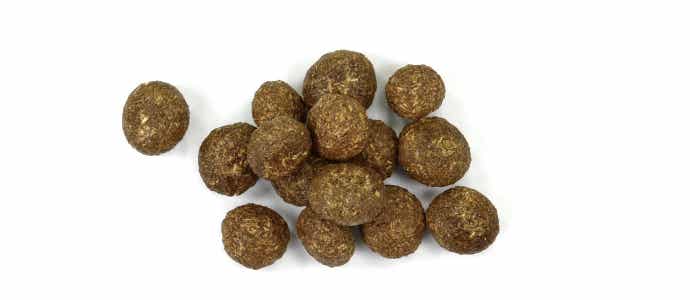
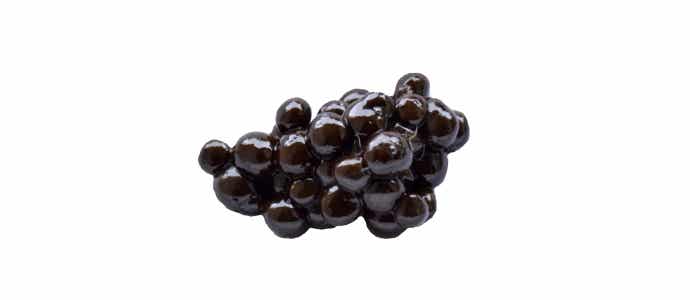
Feeding for Digestive Health
The digestive strategy utilized by rabbits of nibbling high-quality fiber and rapidly sending it through the digestive system not once, but twice gives clues of how to select the diet for a companion rabbit. The diet must utilize high-quality fiber as the main ingredient. High-quality fiber is important for a couple of reasons. First, it is fiber that stimulates the movement of material through the digestive system. Fiber stimulates smooth muscle contraction (peristalsis), which allows food material to pass down the digestive tract. Without adequate fiber, major digestive issues such as stasis, bloat, and ileus occur. These issues are each symptomatic of the digestive system that is not moving. Without proper digestive flow, the rabbit will produce gas and the intestine will become impacted (plugged), which often results in death. High-quality fiber is also important since the digestive strategy of the rabbit is to rapidly ferment fiber. This means only the highest quality fibers will be digested. As plants grow, they accumulate more fiber that is non-digestible to rabbits. Therefore, all fiber sources for rabbits should be from less mature, highly nutritious plants.
Many rabbit owners feed pelleted diets as the primary source of nutrition. This is certainly acceptable provided the fiber content of these pellets is adequate and that the fiber is of high-quality. If the pellet does not contain enough fiber, the rabbit digestive system will not function properly. Further, if the fiber in these pellets is of poor quality, the fiber will not be adequately digested, and weight loss will occur. Pelleted rabbit feeds often contain grains as well. A small amount of grain can be digested in the small intestine; however, a large amount of grain can be a problem. Any grain that is not digested in the small intestine, will pass into the cecum and colon. Bacterial fermentation of grain produces a strong acid that can kill hindgut microorganisms, resulting in disaster for the rabbit.
Finally, many rabbit owners supplement the pelleted forage portion of the rabbit’s diet with long-stem forage, such as alfalfa, timothy or orchard grass. This is done to assist with normal tooth wear and to prevent dental issues. This practice is completely acceptable provided the long-stem forage is of high-quality. Most rabbits, depending on function (pregnant, lactating, growing), can receive 10 – 25% of their diet in the form of long-stem forage with the remaining forage provided in the convenient pelleted form. Standlee Premium Western Forage caters to this market by hand-selecting ultra-premium forages that are packaged in small volumes for companion rabbits.
Feeding rabbits as companion animals is not difficult, as long as you understand the unique features and function of the rabbit digestive system. Feeding adequate amounts of high-quality forage is the key to keeping your rabbit’s digestive system healthy.
If you have questions, please contact the nutritionists at Standlee Premium Western Forage, or consult your veterinarian.
By Dr. Stephen Duren
Standlee Nutritional Expert - Performance Horse Nutrition

